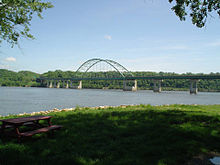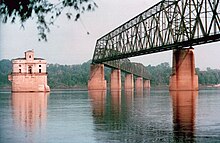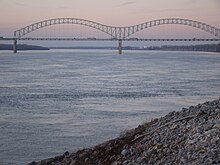The first bridge across the Mississippi River was built in 1855. It spanned the river in Minneapolis, Minnesota where the current Hennepin Avenue Bridge is located.
The first railroad bridge across the Mississippi was built in 1856. It spanned the river between the Rock Island Arsenal in Illinois and Davenport, Iowa. Steamboat captains of the day, fearful of competition from the railroads, considered the new bridge "a hazard to navigation". Two weeks after the bridge opened, the steamboat Effie Afton rammed part of the bridge, catching it on fire. Legal proceedings ensued, with Abraham Lincoln defending the railroad. The lawsuit went to the Supreme Court of the United States and was eventually ruled in favor of the railroad.
Below is a general overview of selected Mississippi bridges which have notable engineering or landmark significance, with their cities or locations. They are sequenced from the Upper Mississippi's source to the Lower Mississippi's mouth.
- Stone Arch Bridge – Former Great Northern Railway (now pedestrian) bridge at Saint Anthony Falls in downtown Minneapolis.

- I-35W Saint Anthony Falls Bridge – In Minneapolis, opened in September 2008, replacing the I-35W Mississippi River bridge which had collapsed catastrophically on August 1, 2007, killing 13 and injuring over 100.
- I-90 Mississippi River Bridge – Connects La Crosse, Wisconsin, and Winona County, Minnesota, located just south of Lock and Dam No. 7.
- Black Hawk Bridge – Connects Lansing in Allamakee County, Iowa and rural Crawford County, Wisconsin; locally referred to as the Lansing Bridge and documented in the Historic American Engineering Record.
- Julien Dubuque Bridge – Joins the cities of Dubuque, Iowa, and East Dubuque, Illinois; listed in the National Register of Historic Places.

- Savanna-Sabula Bridge – A truss bridge and causeway connecting the city of Savanna, Illinois, and the island city of Sabula, Iowa. The bridge carries U.S. Highway 52 over the river, and is the terminus of both Iowa Highway 64 and Illinois Route 64. Added to the National Register of Historic Places in 1999.
- Fred Schwengel Memorial Bridge – A 4-lane steel girder bridge that connects LeClaire, Iowa, and Rapids City, Illinois. Completed in 1966.
- I-74 Bridge – Originally known as the Iowa-Illinois Memorial Bridge, connecting Bettendorf, Iowa, and Moline, Illinois.
- Government Bridge – Connects Rock Island, Illinois and Davenport, Iowa, adjacent to Lock and Dam No. 15; the fourth crossing in this vicinity, built in 1896.
- Rock Island Centennial Bridge – Connects Rock Island, Illinois, and Davenport, Iowa; opened in 1940.
- Norbert F. Beckey Bridge – Connects Muscatine, Iowa, and Rock Island County, Illinois; became first U.S. bridge to be illuminated with light-emitting diode (LED) lights decoratively illuminating the facade of the bridge.

- Great River Bridge – A cable-stayed bridge connecting Burlington, Iowa, to Gulf Port, Illinois.
- Fort Madison Toll Bridge – Connects Fort Madison, Iowa, and unincorporated Niota, Illinois; also known as the Santa Fe Swing Span Bridge; at the time of its construction the longest and heaviest electrified swing span on the Mississippi River. Listed in the National Register of Historic Places since 1999.
- Bayview Bridge – A cable-stayed bridge bringing westbound U.S. Highway 24 over the river, connecting the cities of West Quincy, Missouri, and Quincy, Illinois. Eastbound U.S. 24 is served by the older Quincy Memorial Bridge.
- Clark Bridge – A cable-stayed bridge connecting West Alton, Missouri, and Alton, Illinois, also known as the Super Bridge as the result of an appearance on the PBS program, Nova; built in 1994, carrying U.S. Route 67 across the river. This is the northernmost river crossing in the St. Louis metropolitan area, replacing the Old Clark Bridge, a truss bridge built in 1928, named after explorer William Clark.
- Chain of Rocks Bridge – Located on the northern edge of St. Louis, notable for a 22-degree bend occurring at the middle of the crossing, necessary for navigation on the river; formerly used by U.S. Route 66 to cross the Mississippi.

- Eads Bridge – A combined road and railway bridge, connecting St. Louis and East St. Louis, Illinois. When completed in 1874, it was the longest arch bridge in the world, with an overall length of 6,442 ft (1,964 m). The three ribbed steel arch spans were considered daring, as was the use of steel as a primary structural material; it was the first such use of true steel in a major bridge project.
- Chester Bridge – A truss bridge connecting Route 51 in Missouri with Illinois Route 150, between Perryville, Missouri, and Chester, Illinois. The bridge can be seen in the beginning of the 1967 film In the Heat of the Night. In the 1940s, the main span was destroyed by a tornado.
- Hernando de Soto Bridge – A through arch bridge carrying Interstate 40 across the Mississippi between West Memphis, Arkansas, and Memphis, Tennessee.

- Frisco Bridge – A cantilevered through truss bridge, carrying a rail line across the river between West Memphis, Arkansas, and Memphis, Tennessee, previously known as the Memphis Bridge. When it opened on May 12, 1892, it was the first crossing of the Lower Mississippi and the longest span in the U.S. Listed as a Historic Civil Engineering Landmark.
- Memphis & Arkansas Bridge – A cantilevered through truss bridge bridge, carrying Interstate 55 between Memphis and West Memphis; listed on the National Register of Historic Places.
- Huey P. Long Bridge – In Jefferson Parish, Louisiana, the first Mississippi River span built in Louisiana.
- Crescent City Connection – Connects the east and west banks of New Orleans, Louisiana; the 5th-longest cantilever bridge in the world.
The John James Audubon Bridge between Pointe Coupee Parish and West Feliciana Parish in Louisiana is under construction; when finished, it will be the longest bridge crossing the Mississippi River.
0 comments:
Post a Comment